L'espai
Teatre La Biblioteca is the creation and exhibition space of La Perla 29. With its own programme curated by the company, it is one of the most recognized scenic hubs in the country and annually hosts over 30,000 spectators.
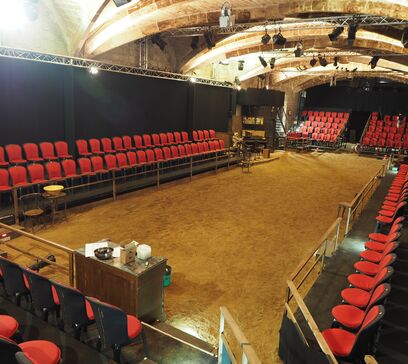
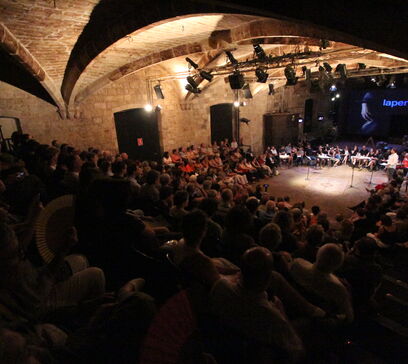
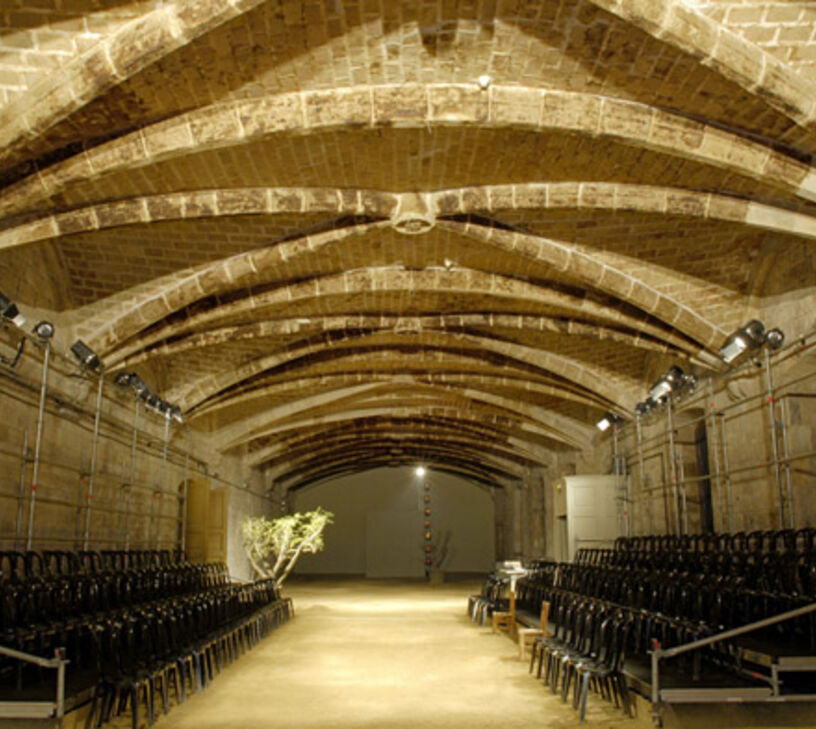
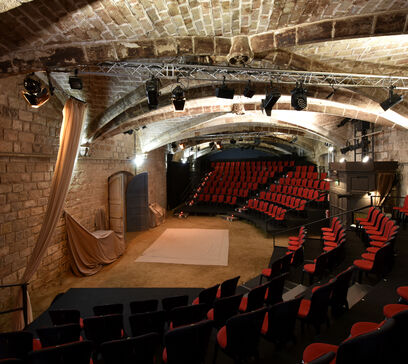
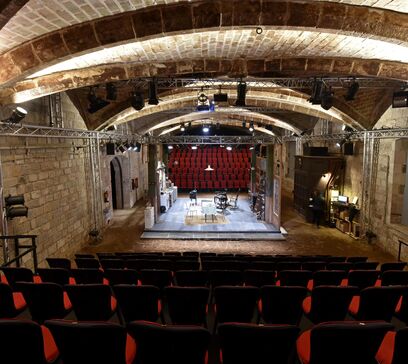
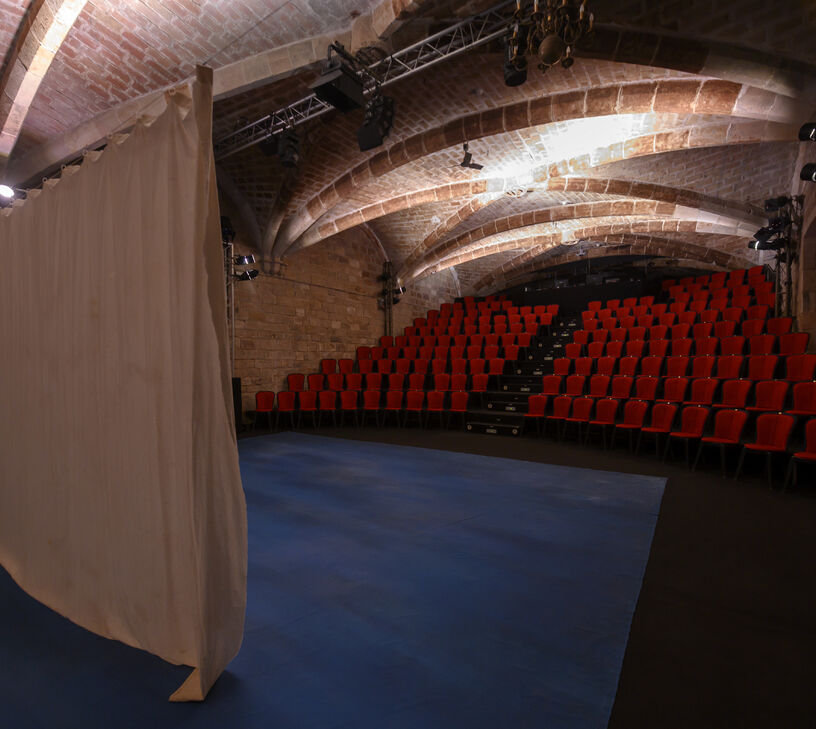
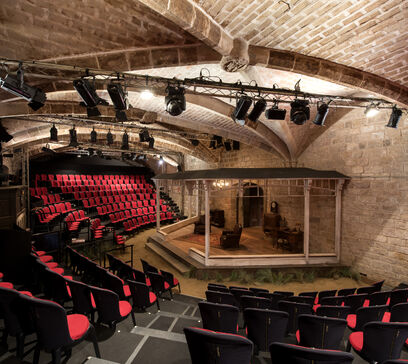
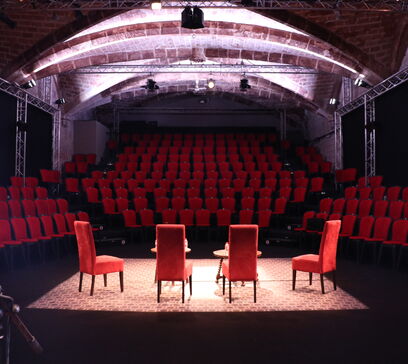
Teatre La Biblioteca is located within one of the Gothic naves of the former Santa Creu Hospital, a 15th-century civil building that, under ecclesiastical administration, provided all the city's medical hospital services and remained active until the late 19th century. Later, the bay was designated for the School of Arts and Crafts. The building is currently owned by the City Council, which partially leases it to the Generalitat de Catalunya, and its various spaces hold a diverse cultural offering: the Massana School, the Institute for Catalan Studies, La Capella, two public libraries, and the National Library of Catalonia.
Teatre La Biblioteca was founded in 2006, and since then has transitioned from intermittent life to a stable and continuous existence. The previous year, La Perla 29 had the opportunity to perform Molière's "Misanthrope" in the Noble Hall of the National Library of Catalonia. During that process, Oriol Broggi stumbled upon the 15th-century vaults on the ground floor of the building by chance. The Library of Catalonia agreed to lend this singular space to La Perla 29 in order to perform "Antigone". It was then that we conditioned the nave, we filled it with sand to improve the acoustics, and thus, Teatre La Biblioteca was born.
Since then, with the support of the Generalitat de Catalunya and the City Council of Barcelona, we kept renewing this concession with the Library of Catalonia for each production. Six years later, once Teatre La Biblioteca had solidified its status as a renowned theater space, we were able to secure a long-term lease. Public support, combined with the financial stability of La Perla 29's theatrical project, have allowed us to transform the Gothic bay into a proppperly functioning theater and creative space.
Jean-Guy Lecat once observed how Teatre La Biblioteca fosters a unique spatial aesthetic where the audience and the stage are integrated. Lecat summarized it with the following expression: "the audience creates the theater's environment."
From the moment the audience crosses the theater's door, they should perceive the transformations of the space. They should dive in an environment that will be different each time and will place them to better understand and experience each play. That's why in our theater the architectural space and the fictional space do not betray each other but rather mutually generate. The spectator's experience begins when they enter the Gothic nave: each time, they find a space that has been completely transformed, and this recognition makes them see it as a magical yet familiar place, surprising yet quotidian, welcoming and uncertain at the same time; in short, a living theater space.
Following Peter Brook, the theater building should be halfway sacred and technical. The theater contains many places within one place. It can hold as many worlds as our imagination generates. This indefinite dream, lost in time, has been a constant challenge for La Perla 29 since the very beginning. We seek to challenge established physical and mental certainties, moving beyond the traditional Italian theater layout that places the audience in front of an elevated stage. We like to overturn these habitual notions and, thanks to the space of Teatre La Biblioteca, we have the opportunity to shift, shape, and play with the boundaries between real space and fictional spaces. This activates the viewer's imagination: they always complete the fiction in their mind.
When this game remains stable over time, the audience also creates the theater's environment understood as a meeting place in the city and the country. Our theater exists because we tell the audience every time, "this is a theater," and they decide to believe in it and to play this game. This has something to do with a collective history raised over the years, with the desire to understand the world through theater and the drive of La Perla 29. The audience creates the environment of this theatrical life, just as they create the environment of each show: it is a social phenomenon that is resumed in every performance.
Theaters should be like small independent republics within a larger city. These spaces should be thought of as specific points from which cultural content radiates, offering new horizons to explore. Theater is "the mirror of society," as the Prince of Denmark sais.
Culture should thrive in all kinds of spaces, emerge throughout the city, engage in dialogue with different architectures, and constantly challenge the audience. Theater should not be confined to conventional spaces, spaces that are already explained by themselves. They shouldn't be preconceived by the general public. They should be flexible. The theatrical space is ephemeral, it may change its purpose and format. This requires us to imagine more, to find different solutions that inspire the creative process and provoke debate for the generated impact on citizens.
Behind a theatrical space, there should be a group of people who bring together as many complicities as possible. It is this understanding that makes a theater a living space. Living in two senses. On one hand, the theater building should be able to play with its walls, entrances, ancillary rooms, and audience arrangement. There should be a communion between the building and its content: the theater should be a construction that aligns with the content. On the other hand, a theater should be a social engine, a place where things are constantly happening. It should be the home of a collective of people who generate content, sensations, new proposals. A vessel for the poetic and political expression of the group that works in and for the space. A resource provided by the city after a dialogue between various actors, administrations, collectives, and after a collaborative work. All these preliminary steps in the theater's creation should move the discourse forward and should activate as many or more things than the actual scenic play.
our newsletter
Vols fer-te soci de l’#AsSocPerla? Tota la informació aquí.
C/ Carme, 44 1r 2ª
Tel. 93 217 17 70
C/ Hospital, 56
Tel. 647 29 37 31
(a partir d'1h i 1/2
abans de la funció)
- Sitemap
- |
- Legal Notice
- |
- Cookies usage
- |
- Contact
- |







